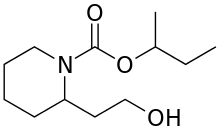Icaridin
| |||
| Names | |||
|---|---|---|---|
| IUPAC name
1-piperidinecarboxylic acid
2-(2-hydroxyethyl)-1-methylpropylester | |||
| Identifiers | |||
| 119515-38-7 | |||
| ChEMBL | ChEMBL2104314 | ||
| ChemSpider | 111359 | ||
| Jmol interactive 3D | Image | ||
| PubChem | 125098 | ||
| UNII | N51GQX0837 | ||
| |||
| |||
| Properties | |||
| C12H23NO3 | |||
| Molar mass | 229.3 g/mol | ||
| Boiling point | 296 °C (565 °F; 569 K) | ||
| Except where otherwise noted, data are given for materials in their standard state (at 25 °C [77 °F], 100 kPa). | |||
| | |||
| Infobox references | |||
Icaridin, also known as picaridin, KBR 3023, under the INCI name hydroxyethyl isobutyl piperidine carboxylate, and the trade names Bayrepel and Saltidin, is an insect repellent. It has broad efficacy against various insects and is almost colorless and odorless.
The name picaridin was proposed as an International Nonproprietary Name (INN) to the World Health Organization (WHO), but the official name that has been approved by the WHO is icaridin. The compound was developed by the German chemical company Bayer and was given the name Bayrepel. In 2005, Lanxess AG and its subsidiary Saltigo GmbH were spun off from Bayer[1] and the product was renamed Saltidin in 2008.[2]
Empirical findings
Icaridin has been reported to be as effective as DEET without the irritation associated with DEET.[3] According to the WHO, icaridin “demonstrates excellent repellent properties comparable to, and often superior to, those of the standard DEET.” In the United States, the Centers for Disease Control and Prevention recommends using repellents based on icaridin, DEET, IR3535, or oil of lemon eucalyptus (containing p-menthane-3,8-diol, PMD) for effective protection against mosquitoes that carry the West Nile virus, Eastern Equine Encephalitis and other illnesses.[4]
Unlike DEET, icaridin does not dissolve plastics.[5]
Icaridin, first used in Europe in 2001, has been reported to be effective by Consumer Reports (7% solution)[6] and the Australian Army (20% solution).[7] Consumer Reports retests in 2006 gave as result that a 7% solution of icaridin offered little or no protection against Aedes mosquitoes (vector of dengue fever) and a protection time of about 2.5 hours against Culex (vector of West Nile virus), while a 15% solution was good for about one hour against Aedes and 4.8 hours against Culex.[8]
Chemistry

Icaridin contains two stereocenters: one where the hydroxyethyl chain attaches to the ring, and one where the sec-butyl attaches to the oxygen of the carbamate. The commercial material contains a mixture of all four stereoisomers.
See also
- SS220, another substituted-piperidine insect-repellant
References
- ↑ Bayer completes spin off of Lanxess AG
- ↑ C&EN News: Saltigo renames insect repellant
- ↑ Journal of Drugs and Dermatology (Jan-Feb 2004)
- ↑ "Traveler's Health: Avoid bug bites". Centers for Disease Control and Prevention.
- ↑ Picaridin.
- ↑ Consumerreports.Org - Consumer Reports Confirms Effectiveness Of New Alternative To Deet
- ↑ http://www.bioone.org/perlserv/?request=get-document&issn=0022-2585&volume=041&issue=03&page=0414
- ↑ "Insect repellents: which keep bugs at bay?" Consumer Reports, June 2006, vol 71 (issue 6), p. 6.
External links
- Picaridin General Fact Sheet - National Pesticide Information Center
- Picaridin Technical Fact Sheet - National Pesticide Information Center
- Choosing and Using Insect Repellents - National Pesticide Information Center
- Article from Journal of Drugs and Dermatology
- EPA fact sheet

